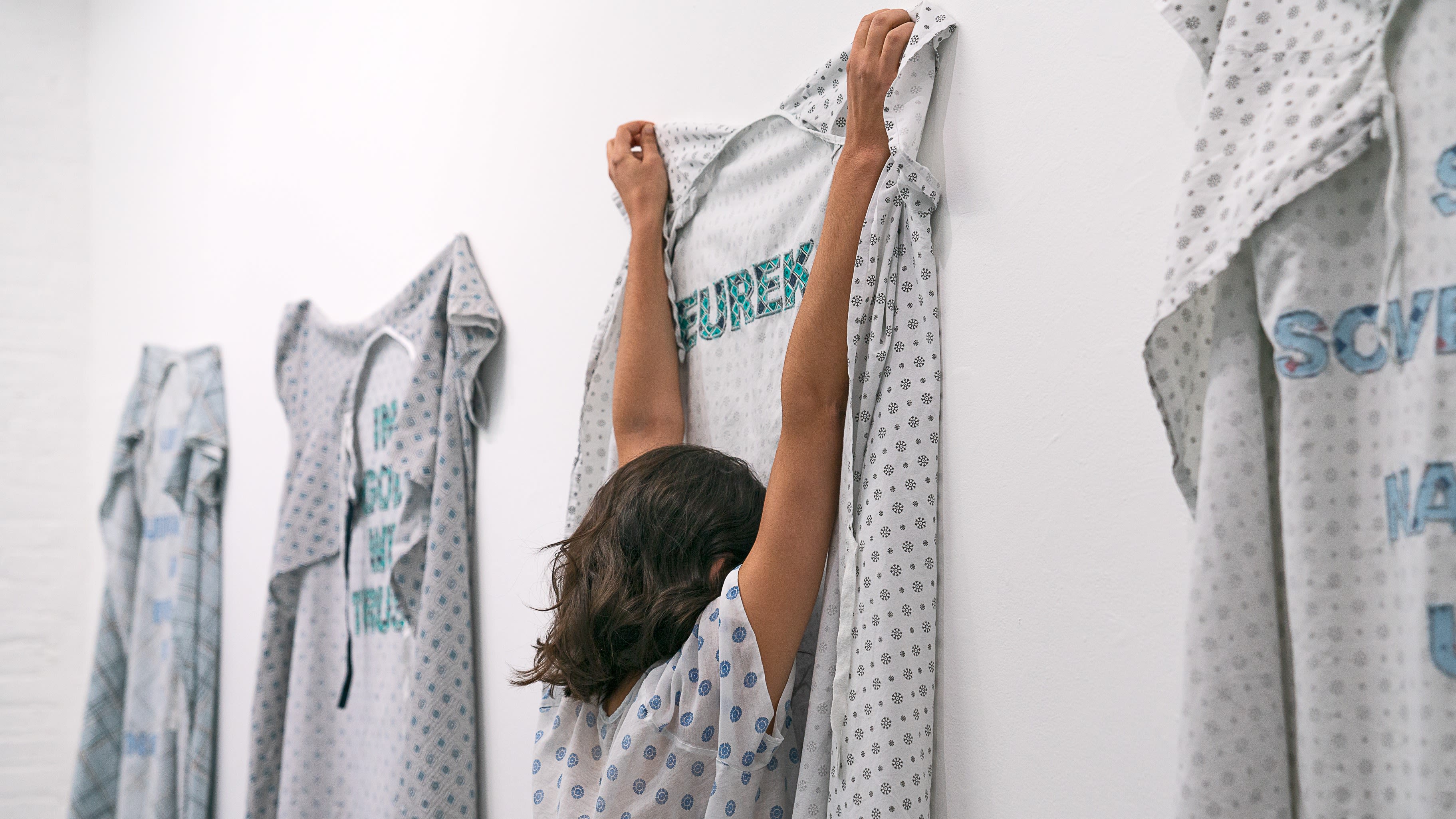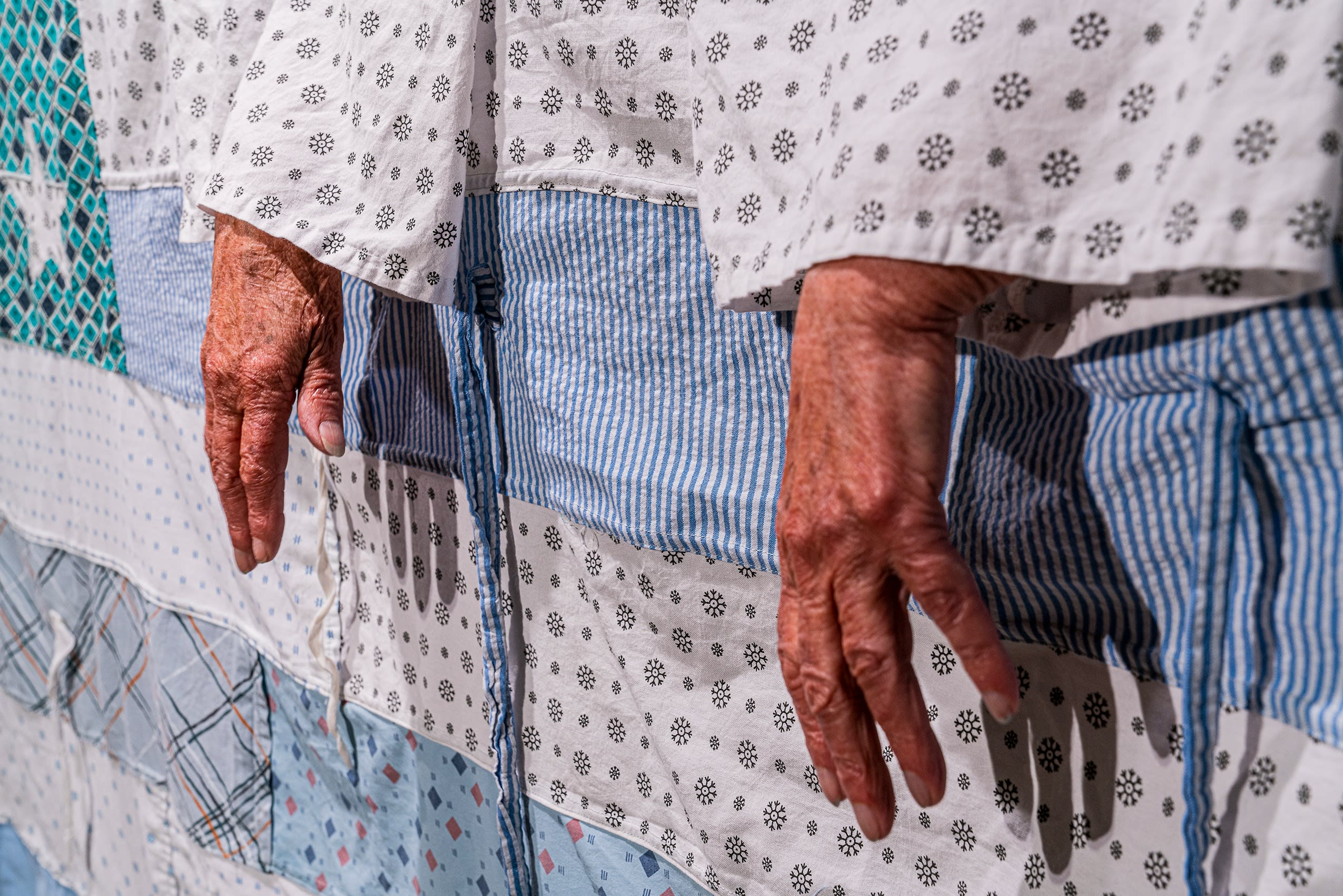At the Intersection of Performance and Activism

Georgia Lale at The Border Project Space in the spring of 2022
The Division of Continuing Education is pleased to highlight past SVACE student and SVA MFA Fine Arts alumnus Georgia Lale— to commend them on their practice as a performance artist and activist.
Could you please provide a brief description of your art practice?
I am a Greek visual artist with Anatolian heritage in the process of becoming a U.S. citizen. Through my multidisciplinary practice, I explore the human body as a blueprint on the social and political realm of modern society. My work explores narratives of forced migration and chronic illness from an interpersonal perspective. As a cancer fighter, I was recently exposed to the hardships that accompany my health condition. My practice is influenced by the cultural confusion and lost ancestral tradition that happened to my family due to prosecution and displacement in the 1920s. My medium palette is characterized by the conceptual minimalistic use of emotionally charged objects such as life vests, emergency heat blankets, and hospital gowns. I use performance, public interventions, painting, sculpture and elements of Sufi symbolism and choreography in order to address the battles that the human body and psyche go through in our complex and multilayered contemporary realities.
What kind of issues does your work reflect or discuss?
My work is addressing immigration, healthcare and womxn rights. I get my inspiration from my personal experience and my ancestral history. By focusing on my personal narrative, I aim to address the global human consciousness experience. Since my cancer diagnosis in 2018, I have been working on a body of work that speaks of my experience as a cancer patient in America before and during the pandemic. My family migrated to Greece as refugees from Manisa, Turkey in 1922, together with 400,000 refugees that the Greek-Turkish war displaced. Members of the Lale family were affiliated with the Mevlevi Sufi Order. I am eager to explore their mysticism and spirituality through my performance and painting practice. We also had a femicide in my family. My great-aunt’s husband, got away with murder after she refused to sing at a wedding. This injustice haunts my family and many womxn that are exposed to domestic abuse. There were 16 femicides in Greece in 2021.

When did you start working in performance?
My first big performance project was developed during my graduate studies at the School of Visual Arts MFA Fine Arts department in 2015. This is when the refugee crisis in Europe was at its peak. I was watching the PBS News Hour and I saw refugees coming to the Greek seashores after having crossed the Mediterranean Sea. They were making the same journey that my family did 100 years ago. I put on an orange life vest and I walked from the Arab to the Greek Galleries of the Metropolitan Museum, symbolically taking the same route with the refugees and commenting on the refugee status of the artifacts. This is how the #OrangeVest performance came to life. As part of the action, a group of people were wearing black clothes and orange life vests. The performance is based on the usage of public spaces and attempts to create an aesthetic balance between a protest and work of art. Despite having elements of a protest, the performers did not disturb everyday public routines. The participants were simply present and quiet. The piece was performed one a month from October 2015 to October 2016, in several landmarks on New York City, in Philadelphia and in Washington D.C. The last performance took place at the European Quarters in Brussels and it was performed by newly arrived refugees and members of the local community.
How do you decide what materials to use in your work?
I am using the objects that come in direct contact with our skin. The things we have no choice but to carry, to feel their physical and psychological weight, like hospital gowns or life vests. A hospital gown immediately categorizes a person as a patient. It is an object that makes you vulnerable, that exposes your medical privacy and your body. It is a costume that we wear when our lives are in the hands of others—doctors, medical professionals, caretakers. I remember myself entering the operation room for my first cancer treatment surgery. I was looking around with excitement because I knew the experience would transform my art practice in unexpected ways. I started collecting hospital gowns during this period. During the quarantine, I made a 10-foot-long American flag out of gowns. Fragments of hospital gowns, such as sleeves, pockets, and laces, form the American flag. Fundamentally, the piece challenges the inadequate health care system and the government’s response during the Covid-19 pandemic, and it honors first responders, essential workers, patients, and the memory of the people that lost the battle with the virus. This flag was shown at my solo show at the Border Project Space in April 2022. There, I performed two three-hour-long pieces at the opening and at the closing reception with hospital gowns that have U.S. state mottos sewn on them. The performance questions the history, meaning, and sincerity of state mottos by positioning them directly on the intimate remnants of the ongoing healthcare crises—hospital gowns.

Do you consider yourself an activist?
The definition of an activist is a person who campaigns to bring political or social change and an artist is, by default, reflecting their times through their art. It is a lot of responsibility to call myself an activist. There are times when I feel that the circumstances are demanding of me to do something, to take a position. If I was a writer, I would write. If I was a politician, I would try to pass legislations and create new laws. I am an artist. My magic power is that I can create visuals that ask the right questions, that engage with the viewers'—the participants'—minds and bodies. Art is inspiring. It can inspire change. It can guide the person through a journey of questioning the establishment. If we ask the right questions, we will get the right answers. I am grateful that I have healthcare through my husband’s employment, but most artists and entertainers cannot afford healthcare in America, together with marginalized communities, immigrants and refugees. Healthcare is a human right, not a luxury. I strongly believe that America can and wants to find a way to offer sufficient healthcare to all its people. I am not fighting for a better future. I am fighting for a sustainable present.
What classes have you taken through CE and how have they influenced your artistic practice?
I took a ceramic throwing wheel class because I wanted to explore my heritage. SVA and SVA CE has provided me with a community that has supported me all the way. It is very essential for a creator to belong to an accepting and loving family and this is what SVA is for me.
Follow our updates and stories on Facebook, Twitter, LinkedIn and Instagram. And meet the SVACE community by reading our new issue of SVA ContinuEd in print or digital versions!

